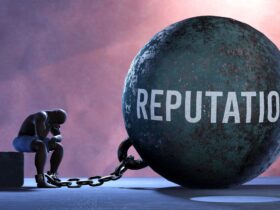In today’s digital landscape, a company’s reputation has become one of its most valuable assets. According to a Harvard Business Review article, so much market value comes from hard-to-assess intangible assets like brand equity and intellectual capital, making organizations especially vulnerable to anything that damages their reputations. Companies with strong positive reputations attract better talent, are perceived as providing more value, and often can charge a premium. However, most companies do an inadequate job of managing their reputations and the risks to their reputations.
The impact of a reputation crisis can be devastating, both in the short-term and long-term. A study found that over 55% of consumers say they would never give business to a brand again once trust is broken, while 65% of data breach victims lost trust in the affected organization. Additionally, 80% of consumers said they would defect from a business if their information was compromised. Clearly, the consequences of a reputation crisis can be severe and long-lasting, underscoring the importance of proactive reputation management.
Key Takeaways
- Reputation is a critical asset for businesses, impacting talent attraction, perceived value, and pricing power.
- Reputation crises can have devastating long-term effects, including loss of trust, reduced customer loyalty, and financial impact.
- Effective reputation management involves understanding reputational risk factors, quantifying and monitoring reputation, and implementing strategic crisis response and recovery plans.
- Communicating transparently with stakeholders and shaping public perception are crucial during a reputation crisis.
- Rebuilding trust and restoring a positive reputation requires a multi-faceted approach, including engaging employees, managing content, and regaining consumer confidence.
Understanding Reputational Risk
In the dynamic business landscape, reputational risk has emerged as a crucial factor that can significantly impact an organization’s long-term success. According to industry experts, 70% to 80% of a company’s market value can be attributed to intangible assets like brand equity, intellectual capital, and goodwill. This underscores the importance of proactively managing reputational risk to maintain a strong, positive public perception.
The Reputation-Reality Gap
One of the primary contributors to reputational risk is the reputation-reality gap, which refers to the discrepancy between a company’s perceived reputation and its actual practices and performance. This disconnect can lead to a loss of trust among stakeholders, ultimately impacting the organization’s market value and customer loyalty.
Changing Beliefs and Expectations
Another factor that can increase reputational risk is the evolving beliefs and expectations of stakeholders, including customers, employees, and the general public. As societal norms and values shift, companies must adapt their behaviors and communication strategies to align with these changing perceptions. Failing to do so can result in a damaged brand reputation and a loss of credibility.
| Reputational Risk Factors | Impact |
|---|---|
| Reputation-Reality Gap | Loss of trust, decreased market value, and reduced customer loyalty |
| Changing Beliefs and Expectations | Damaged brand reputation, loss of credibility, and inability to meet stakeholder demands |
By understanding these key factors that contribute to reputational risk, organizations can develop proactive strategies to mitigate potential crises and maintain a strong, positive brand image in the eyes of their stakeholders.
Quantifying and Assessing Reputation Crisis
When a reputation crisis strikes, it’s crucial to assess the severity of the situation. This involves quantifying changes in corporate reputation, declines in perception among employees and stakeholders, and negative attitudes toward the company. It’s also important to identify any executives or specific brand entities directly responsible for the crisis and monitor the situation across social media and online.
Identifying the Severity
Capturing non-media metrics like sales performance, profitability, and share prices can provide a comprehensive understanding of the crisis and its impact. According to a Deloitte survey, 88% of brand executives view reputation risk as a top strategic business concern. Businesses with one negative article online risk losing up to 22% of prospective customers, while those with four or more negative articles can lose up to 70% of potential customers.
Monitoring Online Channels
In today’s digital age, 97% of people look online to learn more about a business, and 86% of Americans get their news online. It’s crucial to closely monitor social media, review sites, and other online channels to gauge the extent and spread of the reputation crisis. By quantifying the crisis and assessing its severity, organizations can develop targeted strategies to mitigate the damage and protect their hard-earned reputation.

Reputation Crisis Management Strategies
When facing a reputation crisis, it’s crucial to have a well-structured plan in place to communicate with your key stakeholders and shape public perception. This two-pronged approach can help you effectively navigate the crisis and minimize long-term damage to your brand.
Communicating with Stakeholders
Proactive communication with your stakeholders, including business partners, investors, customers, and employees, is essential during a reputation crisis. Provide them with factual details about the situation and the measures you’re taking to resolve it. This transparency can help maintain trust and confidence in your brand.
A crisis management team, typically comprising executives, public relations professionals, legal experts, and HR representatives, should be responsible for coordinating and delivering these messages. Consistent and timely communication across all platforms is key to ensuring your stakeholders feel informed and reassured.
Shaping Public Perception
To shape public perception during a reputation crisis, leverage the media by issuing a well-crafted public statement. Choose a spokesperson who can effectively convey your message and demonstrate your brand’s commitment to addressing the situation. Your approach should depend on whether your brand is at fault, not at fault, or facing a mistruth.
Maintaining a consistent and transparent communication strategy across all platforms, including social media, your website, and any public statements, is crucial during this process. By proactively managing the narrative, you can help restore trust and protect your brand’s reputation.
Reputation crisis management is a complex and multifaceted challenge, but by prioritizing communication with stakeholders and shaping public perception, you can navigate the crisis effectively and emerge stronger than ever. Leveraging the right strategies and tools can help you weather the storm and boost your brand’s reputation in the long run.
Rebuilding Trust and Reputation
Rebuilding trust and reputation after a crisis is a delicate and vital process that requires a multi-faceted approach. Acknowledging mistakes promptly and transparently is crucial to regaining credibility. Taking immediate corrective action to address the root cause is essential to prevent recurrence and demonstrate accountability.
Engaging Employees
Employees are crucial brand ambassadors during a reputation crisis. It’s important to ensure they understand the situation and are empowered to contribute to the recovery process. By fostering a culture of accountability within the organization, companies can set clear policies and mechanisms for holding individuals and teams responsible, further strengthening trust.
Content Management
Rebuilding a tarnished reputation involves closely monitoring online conversations, publishing a formal apology, and relentlessly publishing positive content. This strategic content management approach helps control the narrative and reduce speculation, emphasizing the importance of transparency.
Regaining Consumer Trust
Regaining consumer trust is essential for long-term reputation recovery. This can be achieved by conveying the brand’s core values, financial stability, longevity, and positive feedback. Customer-centric solutions that prioritize customer needs and concerns play a key role in restoring stakeholder confidence.
Ultimately, rebuilding trust and reputation after a crisis requires continuous improvement, transparency, and a commitment to change. By leveraging these strategies, businesses can effectively navigate the path to reputation recovery and regain the trust of their employees, customers, and stakeholders.
Conclusion
Rebuilding a brand’s reputation after a crisis is a challenging but essential task. As the article has outlined, a well-defined plan is crucial to mitigate the long-term effects of a reputation crisis. By following a comprehensive five-step process – assessing the damage, aligning stakeholders, developing a communications strategy, establishing a trust-building plan, and planning for the future – businesses can work to regain the trust and confidence of their customers and the public.
Implementing strong marketing and cybersecurity practices can also play a vital role in managing a brand’s reputation and avoiding the pitfalls of a crisis. With 88% of brand executives considering reputation risk a top strategic concern and over 65% of business leaders believing social media can exacerbate a brand crisis, the importance of proactive reputation management cannot be overstated.
As Warren Buffett famously said, “It takes 20 years to build a reputation and five minutes to ruin it.” By taking the necessary steps to protect and rebuild their brand’s reputation, businesses can ensure that their hard-earned reputation is not lost in the blink of an eye. With a steadfast commitment to transparency, accountability, and customer-centric practices, organizations can emerge from a crisis stronger and more resilient than ever before.
FAQ
What factors affect the level of reputational risks?
According to the Harvard Business Review article, the three factors that affect the level of reputational risks are the reputation-reality gap, changing beliefs and expectations, and weak internal coordination.
How can companies quantify and assess the severity of a reputation crisis?
When a reputation crisis hits, it’s crucial to first assess the severity of the situation. This involves quantifying changes in corporate reputation, declines in perception among employees and stakeholders, and negative attitudes toward the company. It’s also important to identify any executives or specific brand entities directly responsible for the crisis and monitor the situation across social media and online channels.
What are the key strategies for managing a reputation crisis?
The article highlights the importance of communicating the impact of the crisis to key stakeholders, shaping public perception through media engagement, empowering employees as brand ambassadors, and taking control of communication platforms to rebuild the reputation.
How can companies rebuild trust and reputation after a crisis?
Rebuilding the reputation involves revising content, removing damaging content, and publishing positive content relentlessly. Regaining consumer trust is essential, which can be achieved by conveying the brand’s core values, financial stability, longevity, and positive feedback.
What is the five-step process for reputation recovery after a crisis?
The five-step process outlined in the article for rebuilding brand reputation includes: 1) Assessing the extent of the damage, 2) Aligning stakeholders, 3) Developing a communications strategy, 4) Establishing a trust-building plan, and 5) Planning for the future.















